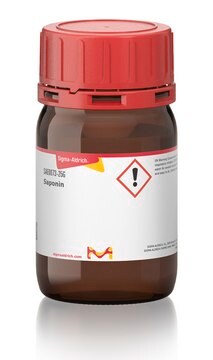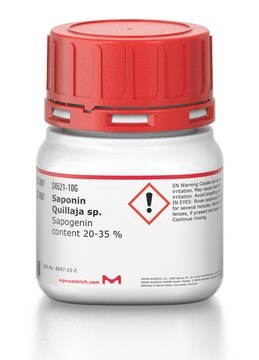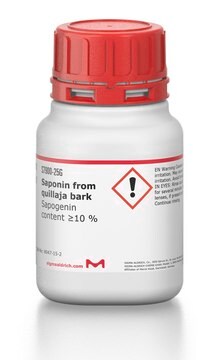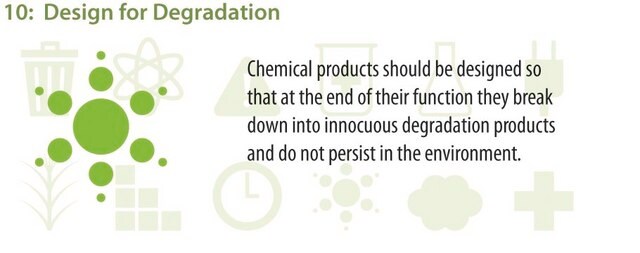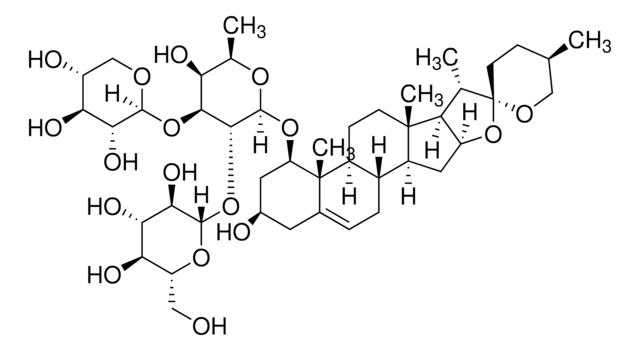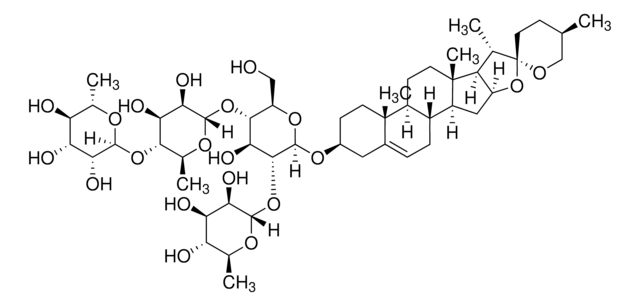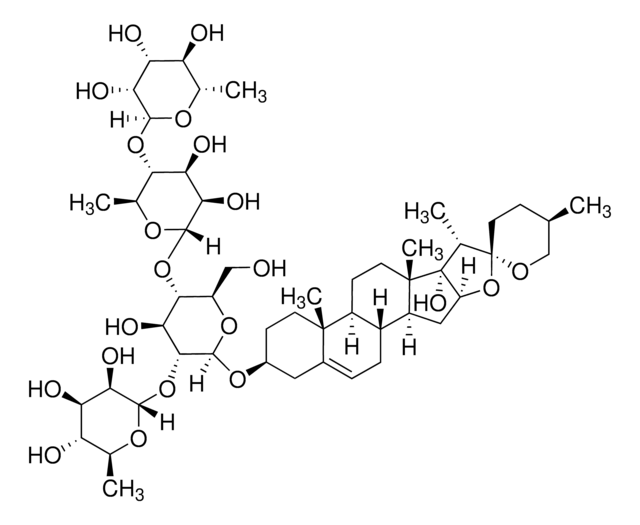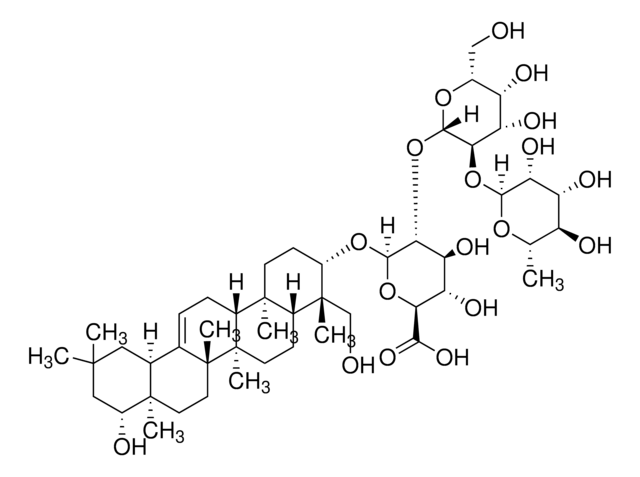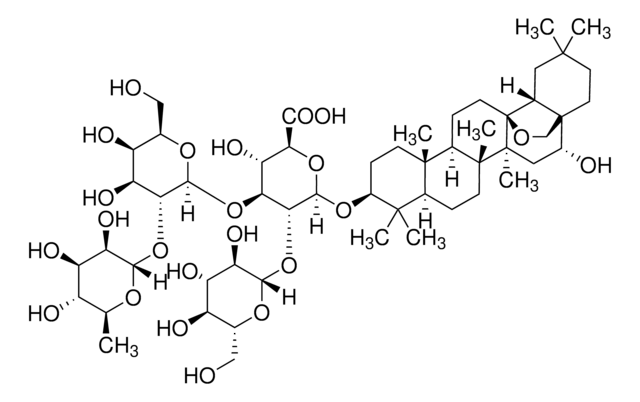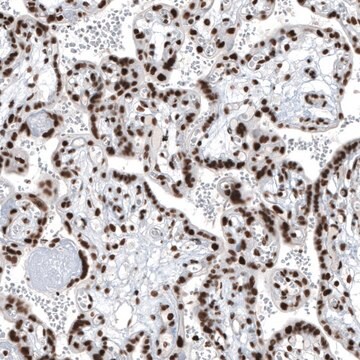84510
Saponin
used as non-ionic surfactant
Sinónimos:
glycosides, saponins
About This Item
Productos recomendados
origen biológico
plant (Quillaya)
Formulario
powder
composición
Sapogenin, 8-25%
características de los productos alternativos más sostenibles
Less Hazardous Chemical Syntheses
Use of Renewable Feedstocks
Learn more about the Principles of Green Chemistry.
sustainability
Greener Alternative Product
técnicas
HPLC: suitable
protein quantification: suitable
impurezas
≤20% sulphated ash
CMC
0.001-0.01%
solubilidad
water: 1 g/10 mL, clear to hazy, yellow to brown
densidad
1.015-1.020 g/mL at 20 °C (5% in H2O)(lit.)
categoría alternativa más sostenible
cadena SMILES
C[C@]1(CCC23COC4([C@H]2C1)CC[C@@H]5[C@]6(CC[C@@H](C(C6CC[C@]5([C@@]4(C[C@H]3O)C)C)(C)C)O[C@H]7[C@@H]([C@H]([C@H](CO7)O[C@H]8[C@@H]([C@H]([C@@H](CO8)O)O)O)O[C@@H]9[C@@H]([C@H]([C@@H]([C@H](O9)CO)O)O)O)O[C@H]1[C@@H]([C@H]([C@@H]([C@H](O1)CO)O)O)O[C@@H]1[C@@H]([C@H]([C@@H]([C@H](O1)CO)O)O)O)C)C=O
InChI
1S/C58H94O27/c1-52(2)29-7-11-55(5)30(8-12-58-31-15-53(3,22-62)13-14-57(31,23-77-58)32(64)16-56(55,58)6)54(29,4)10-9-33(52)82-50-46(85-51-45(40(71)37(68)27(19-61)80-51)84-49-43(74)39(70)36(67)26(18-60)79-49)44(83-48-42(73)38(69)35(66)25(17-59)78-48)28(21-76-50)81-47-41(72)34(65)24(63)20-75-47/h22,24-51,59-61,63-74H,7-21,23H2,1-6H3/t24-,25-,26-,27-,28+,29?,30-,31+,32-,33+,34+,35-,36-,37-,38+,39+,40+,41-,42-,43-,44+,45-,46-,47+,48-,49-,50+,51+,53-,54+,55-,56+,57?,58?/m1/s1
Clave InChI
MAEBCGDGGATMSC-OSHGGGOQSA-N
¿Está buscando productos similares? Visita Guía de comparación de productos
Descripción general
Beyond their structural uniqueness, saponins play essential roles in biochemical processes, acting as secondary metabolites that facilitate protein penetration through cell membranes. Studies indicate their amphipathic nature and potential as hemolytic agents, contributing to their utility in immunoassays by stimulating the Th1 immune response and cytotoxic T-lymphocyte production. In cell biology, saponins find applications as nonionic surfactants, influencing cellular processes and interactions.
Moreover, saponins serve as promising components in vaccine research, functioning as adjuvants that can activate the mammalian immune system. This property, combined with their ability to solubilize low-density lipoproteins and regulate cholesterol concentration in micelles, makes saponins versatile and valuable in multidisciplinary research areas, including biochemical and cell biology research.
Aplicación
- as a wetting agent to study its effects on the floatability of six plastics
- to permeabilize washed neutrophils for immunofluorescence
- as a supplement in phosphate buffer saline (PBS) for immunocytochemistry
Acciones bioquímicas o fisiológicas
Características y beneficios
- Suitable for Biochemical and Cell Biology research
- Can be used with HPLC and Protein Quantification
- High purity product for research applications
Otras notas
producto comparable
Palabra de señalización
Warning
Frases de peligro
Consejos de prudencia
Clasificaciones de peligro
Eye Irrit. 2 - STOT SE 3
Órganos de actuación
Respiratory system
Código de clase de almacenamiento
11 - Combustible Solids
Clase de riesgo para el agua (WGK)
WGK 2
Punto de inflamabilidad (°F)
Not applicable
Punto de inflamabilidad (°C)
Not applicable
Equipo de protección personal
dust mask type N95 (US), Eyeshields, Gloves
Elija entre una de las versiones más recientes:
¿Ya tiene este producto?
Encuentre la documentación para los productos que ha comprado recientemente en la Biblioteca de documentos.
Los clientes también vieron
Nuestro equipo de científicos tiene experiencia en todas las áreas de investigación: Ciencias de la vida, Ciencia de los materiales, Síntesis química, Cromatografía, Analítica y muchas otras.
Póngase en contacto con el Servicio técnico
